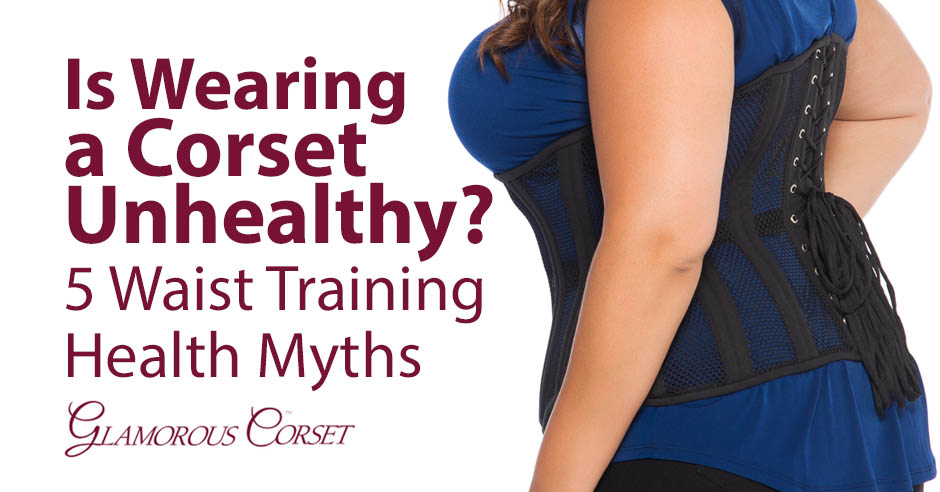Blog
Is Wearing a Corset Unhealthy? 5 Waist Training Health Myths
Myths and urban legends don’t just apply to ghost stories and swamp monsters. There are also many commonly held beliefs about corseting that are far from true, stemming from Victorian era doctors and scam artists. With a lack of scientific knowledge about women’s health, many ailments were blamed on corsets. In turn, swindlers tried to make an easy buck by selling “health corsets,” which they claimed would avoid negative side effects.
Of course, these so-called “health” corsets were hardly different than a regular corset, and misconceptions held by Victorian doctors were disproved long ago. However, many untruths about corsets remain. These five myths about corsets and health are repeated often among the general public, but as you’ll come to find out, they’re little more than old wives’ tales.
Myth 1: Corsets Damage Your Organs
One of the most common myths about corsets is that they can damage internal organs. In reality, corsets do compress your organs – but so does bending, leaning, sitting, and, of course, pregnancy! Women’s organs in particular are equipped to shift around, but that said, any shifting that takes place while wearing a corset is minor.
Because of this compression, you may find your appetite to be a bit suppressed while wearing a corset. Carbonated beverages, like beer and soda, cause bloat, which can be uncomfortable while laced up. For this reason, many avoid these beverages while wearing a corset.
Myth 2: Corsets Limit Your Breathing
If you feel short of breath or lightheaded while wearing a corset, take it off immediately. Chances are, the laces have been cinched too tight. Leave it off until you feel back to normal, then use a mirror or the help of a friend to position and lace your corset in a comfortable position. If you’re unsure about how to lace up a corset, check out our step-by-step guide.
A question that often comes along with this is if it’s okay to exercise in a corset. Click here to find the many reasons we advise against this.
Myth 3: Corsets Reshape Your Lungs
Contrary to popular belief, a corset does not reshape your lungs. Instead, the steel bones of a corset work with your body to shape the fleshy bit of your abdomen, correct bad posture, and train your waist into an hourglass shape.
Many people believe that Victorian women were prone to fainting because corsets had shaped their lungs into a cylinder, but that’s simply not true. As the History channel explains, there is no evidence to suggest that ladies of the Victorian age laced themselves any tighter than we do today.
Myth 4: Corsets Weaken Your Muscles
Another frequent misconception is that as the wearer gets used to the support of a corset, their back muscles weaken. In reality, the opposite is true! A corset actually strengthens back muscles by forcing you to stand (or sit) up-right with good posture. Because your body may not be used to this position, it’s not uncommon to feel some soreness akin to a good gym workout when your first begin corseting. This simply means that muscles you haven’t used before are getting stronger.
If you are feeling particular strain on your back muscles, it may be a good idea to work some simple yoga stretches into your daily routine. You should also limit your wear time, slowly working your way to longer sessions. This will give your body time to adjust to the changes.
Myth 5: Corsets Cause Skin Infections
Some say that a tight corset creates an environment that is prone to skin infections. That should not be the case if you are following good hygiene and wearing a corset liner. You should also be sure to clean your corset often. If you have questions about how to hand-wash your corset, see: How to Wash a Corset: A Guide to Cleaning Your Corset.
Have you heard other myths about corsets? Let us know on Facebook or in an email. We’d love to hear from you!

My name is Rachel, I am the owner of Glamorous Corset, a small business founded by me in 2010. Back In 2005, I was in a car accident that left me with a herniated disk. Much to my surprise I learned steel boned corsets were beneficial to several medical injuries including mine. I was always intrigued with corsetry, their history and their beautiful aesthetic. I love sharing knowledge about corsets, educating my wonderful readers and breaking the negative stigma related to corsetry. In combination with my years of research and personal experience I hope my articles are useful and can help anyone who has struggled with some of the same things I have. More about me…


